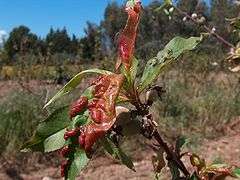Leaf curl
| Leaf curl | |
|---|---|
 Peach leaf curl | |
| Causal agents | Taphrina fungi, Begomovirus |
| Hosts | peach, almond |
| Distribution | America, Europe, Asia, Africa, Australia, New Zealand |
Leaf curl is a plant disease characterized by curling of leaves, and caused by a fungus, genus Taphrina,[1] or virus, especially genus Begomovirus of the family Geminiviridae. One of the most notable types is peach leaf curl, caused by the fungus Taphrina deformans, which infects peach, nectarine, and almond trees. Taphrina deformans is found in America, Europe, Asia, Africa, Australia, and New Zealand.[2] It was first introduced in America in 1852 and has now spread all over the country.[3]
Problems with leaf curl
Peach leaf curl reduces the amount of leaves and fruit produced by peach and nectarine trees.[3] The disease costs the United States 2.5 to 3 million dollars annually.[3]
Causes of leaf curl
The fungus Taphrina deformans causes deformed young leaves, red blisters and ultimately the whitish bloom that covers the leaf as the infection progresses. This white color is made of asci that break through the cuticle of the leaf. One ascus consists of eight ascospores that create conidia, which are ejected in early summer and spread by rain and wind. The fungus survives the winter on the surface of the host plant, such as on bark or buds.[2] In the winter, rainwater washes spores into the buds as they burst. Once this happens, no treatment is effective. In the spring, new leaves are infected by the conidia as the leaves emerge from the buds. The disease may not occur every year due to variation in temperature and rainfall. Specifically, for successful infection, the fungus requires cool and wet winters, where rain (not fog or dew) wets the tree for more than 12.5 hours at temperatures below 16 °C (61 °F).[4]
Signs of Disease
Leaf Curl is distinctive and easily noticeable, and the severity of the signs depends on how early infection has occurred. Diseased leaves can usually be identified soon after they emerge from the bud, due to their red color and twisted shape. As the leaves develop, they become increasingly distorted, and ultimately thick and rubbery compared to normal leaves. The colors of the leaves change from the normal green to red and purple, until finally a whitish bloom covers each leaf. Changes in the bark are less noticeable, if at all. Fruit may fail to develop from diseased blossoms, or may be affected, showing a reddish color.[3] Infected leaves fall early. The tree usually produces a second flush of leaves that is rarely diseased, except in an unseasonably cool and wet spring, because the fungus is not infectious at the normally higher temperatures in late spring and early summer.
Control of the disease
Various methods are applied.
- The most effective method[5] is to plant peach trees against a house wall under an overhanging roof, possibly covered by a mat during the winter, to keep winter rain from the buds before they burst (and incidentally to delay blossoming until spring frosts are over), until the temperature exceeds 16 °C (61 °F) in the spring, deactivating the fungus.
- Commercially, spraying the leaves with fungicides is the most common control method. The toxicity of these fungicides means they are not legally available to non-commercial growers in some countries. Spraying should be done in the winter well before budding. If trees are not sprayed early enough, treatment is ineffective. Copper-based mixtures (such as Bordeaux mixture) and lime sulfurs are two fungicides commonly used.[2][6]
- Peach cultivars can be planted which show some resistance to peach leaf curl, or at least regenerate rapidly, such as Peach Benedicte.[7] No similarly resistant nectarine cultivar is yet known.
If a plant appears to have signs of leaf curl in a particular year, the disease will take its course, but precautions can be taken to sustain the tree or maximize crop yield: for example, treating with nitrogen and excess water to minimize stress on the tree; applying greasebands around the trunk to protect from insect infestation; and thinning the fruit. It is unclear whether removal of infected leaves from the tree is beneficial.[8] Removing the infected leaves and fruit after they fall to the ground is sometimes also suggested but superfluous if, in the following winter, fungicides or rain protection are applied.
USDA 1992 5-year plan
This USDA document describes a 5-year plan starting in 1992 to mitigate whiteflies.[9]
References
- ↑ Peach leaf curl, Taphrina deformans at West Virginia University
- 1 2 3 Gray, William D.. The Relation of Fungi to Human Affairs. New York: Henry Holt and Company, Inc., 1959. Print.
- 1 2 3 4 Chester, Kenneth Starr. Nature and Prevention of Plant Diseases. 2nd. Philadelphia: The Blakiston Company, 1947. Print.
- ↑ Rossi, V. et al. (2006). Influence of Environmental Conditions on Infection of Peach Shoots by Taphrina deformans. Phytopathology 96:155-163. PMID 18943918
- ↑ Royal Horticultural Society. Peach Leaf Curl.<http://apps.rhs.org.uk/advicesearch/profile.aspx?pid=232>
- ↑ "Peach--Leaf Curl." An Online Guide to Plant Disease Control. 01 Jan 2008. Oregon State University. 14 Apr 2009 <http://plant-disease.ippc.orst.edu/disease.cfm?RecordID=794>.
- ↑ LWG [Bavarian State Institute for Viticulture and Horticulture]. Field trials on peach and nectarine trees regarding peach leaf curl.<http://www.lwg.bayern.de/gartenbau/obstbau/17687/>
- ↑ University of California (2012) Integrated Pest Management Program - Peach leaf Curl. <http://www.ipm.ucdavis.edu/PMG/PESTNOTES/pn7426.html >
- ↑ DeQuattro, Jim, and Dennis Senft, and Marcia Wood. "The Whitefly Plan: A five-year Update." 06 Feb 2007. United States Department of Agriculture: Agricultural Research Service. 14 Apr 2009 <http://www.ars.usda.gov/is/AR/archive/feb97/fly0297.htm>.
External links
| Wikimedia Commons has media related to Taphrina deformans. |
- Index Fungorum
- USDA ARS Fungal Database
- Royal Horticultural Society - Peach Leaf Curl
- Treatment of peach leaf curl